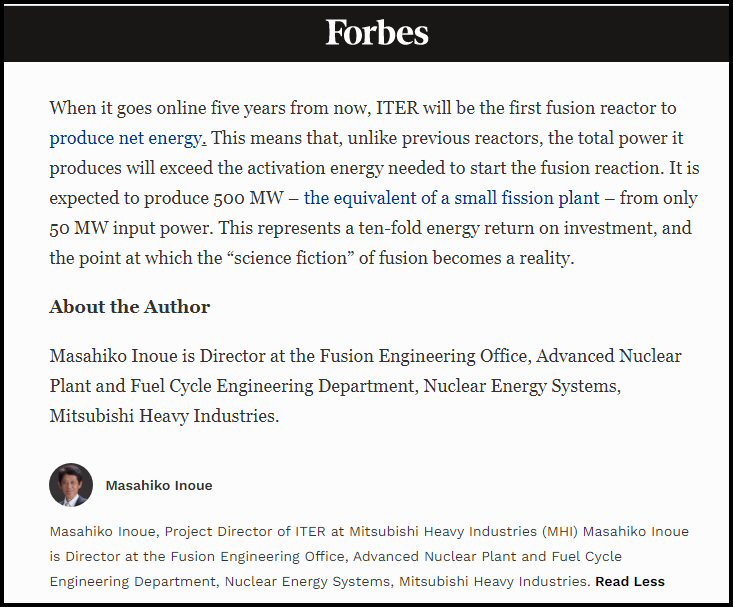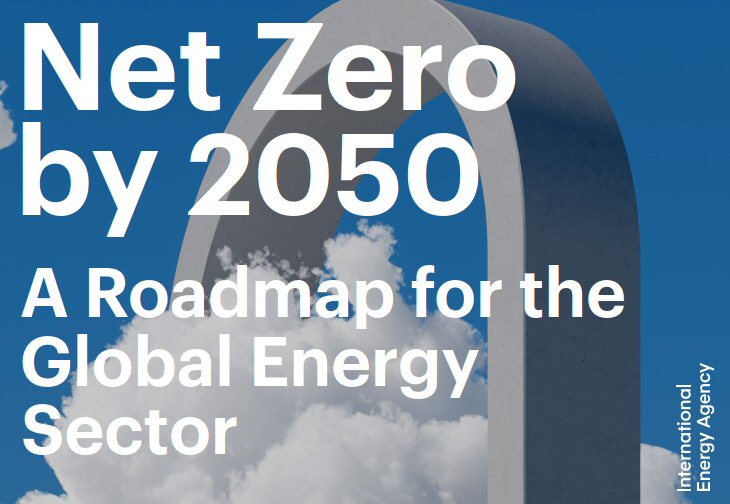Return to ITER Power Facts Main Page
December 7, 2020
Luo Delong, Chair of the ITER Council
Huang Wei, Vice-Minister of Ministry of Science and Technology, (China)
Massimo Garribba, Deputy Director-General, DG Energy, European Commission (European Union)
Ravi Bhushan Grover, Member, Atomic Energy Commission (India)
Matsuo Hiroki, Senior Deputy Minister of Education, Culture, Sports, Science and Technology (Japan)
Chang-Yune Lee, Director General, Space and Nuclear Energy Bureau, Ministry of Science and ICT (Korea)
Igor Borovkov, Deputy Chief of Staff of the Government Executive Office of the Russian Federation (Russia)
Steve Binkley, Principal Deputy Director of the Office of Science, Department of Energy (U.S.)
Open Letter To the Chair and Heads of Delegation of the ITER Council:
Your organization is taking billions of taxpayer dollars in exchange for promises to the public that you know the ITER reactor will never deliver. You can’t change the reactor’s design but you can correct your claims. I encourage you to do so.
June 16, 2020, Letter
On June 16, 2020, in advance of the 26th ITER Council meeting, I wrote to some of you and explained the systemic pattern of false and misleading fusion claims that have surrounded the ITER project, including some of the activities of Director-General Bernard Bigot and the Head of Communications, Laban Coblentz.
After the 26th ITER Council meeting, I saw no improvement in the accuracy of the ITER organization’s public claims. Instead, a month after ITER Council 26, Bigot and Coblentz published a press release about ITER that contained a fraudulent claim about the primary measurable objective of the ITER project.
Nov. 15, 2020, Letter
On Nov. 15, 2020, I wrote to all the delegates of ITER Council 27. I brought the systemic patterns of false claims by Bigot and Coblentz to your attention. I provided you with samples of misleading claims on the ITER organization’s Web site. I provided you with samples of the many consequences of your organization’s false and misleading public claims.
In order to encourage positive change, I also provided you with a three-point outline of an accurate and transparent description of the primary measurable objective of the ITER project. I requested that the council inform me of its intentions by Nov. 23. Nobody from the council wrote back to me, let alone argued with any statement I made or facts that I presented.
At this point, every member of the council understands the problem. Every member of the council has an accurate and transparent description of the project available to use, if the council intends to honestly, accurately, and transparently describe the ITER project to the public.
Today, I’m going one step further, providing you with a condensed version of an accurate, transparent description of the ITER project.
Primary Measurable Objective
The primary measurable objective of the ITER reactor is the production of fusion reactions that have a thermal output of 500 megawatts. The input requires 50 megawatts of heat to be injected continuously into the reaction chamber. ITER is not designed for net power for the overall reactor; therefore, the 50-megawatt value does not include the power required to operate the reactor.
Let me remind you that, when communicating with the public, using the phrase “fusion power” when you actually mean “fusion reaction power” is dishonest. Everybody but plasma physicists thinks that fusion power is a form of power generation that would generate electricity. They think that claimed fusion power values represent usable, net rates of power (thermal or electric) that would be produced by fusion reactors. Nobody but plasma physicists understands that your use of the phrase fusion power applies only to the physics of the fusion reaction and that it fails to account for power required to operate a fusion device. Therefore, telling the public that ITER, which is equivalent to a zero-net-power reactor, is designed to produce “500 MW of fusion power” is dishonest.
In the words of Johannes Schwemmer, advice which he himself did not follow, the accurate way to represent the primary objective and goal of ITER is to “ensure that there is no possible misunderstanding on the ITER energy gain of 10- [that it is] linked only to the plasma and not to the energy balance of the overall ITER plant.”
In the words of European Commissioner Arias Cañete, who was apparently misinformed by the ITER management, “the IO Web site now states unambivalently that the performance of ITER will be assessed by the so-called fusion Q, i.e., by comparing the thermal power output of the plasma with the thermal power input into the plasma.”
Your collaborator Masahiko Inoue, on behalf of Mitsubishi Heavy Industries, published an advertisement earlier this year demonstrating a perfect example of many of the false and misleading claims.

Excerpt from Mitsubishi Heavy Industries advertisement on Forbes Web site, July 13, 2020
You now have a concise, accurate, honest, and transparent three-sentence summary that describes the primary measurable objective of the ITER project. If the council intends to move forward with improved communications, please let me know by Dec. 18.
If you do not intend to communicate to the public accurately, honestly, and transparently, what conclusion can be drawn other than the entire upper management of the ITER organization is corrupt?
Sincerely,
Steven B. Krivit
Publisher and Senior Editor, New Energy Times
DISTRIBUTION
European Parliament
David Maria Sassoli, President
European Commission
Ursula von der Leyen, President
CHAIR OF THE ITER COUNCIL
Luo Delong
ITER COUNCIL — CHINA
Representatives
Huang Wei, Head of Delegation, Vice-Minister of Ministry of Science and Technology (MOST)
Chen Linhao, Deputy Director-General, Department of International Cooperation, Ministry of Science and Technology, MOST
Wang Min, Deputy Director-General, ITER CN DA
Experts
Zhou Wenneng, Deputy Director-General, MOST
LI Xinshuo, Third Secretary, Ministry of Foreign Affairs
Li Chunjing, Director, MOST
Yang Xuemei, Director, MOST
He Kaihui, Director, ITER CN DA, MOST
Liu Lili, Deputy Director, ITER CN DA, MOST
You Jiayu, Project Officer, MOST
Chen Yingqiao, Project Officer, ITER CN DA, MOST
ITER COUNCIL — EURATOM
Representatives
Massimo Garribba, Head of Delegation, Deputy Director-General, DG Energy, European Commission
Beatrix Vierkorn-Rudolph, Chair of the Governing Board, F4E/Euratom Domestic Agency
François Jacq, High Representative for ITER in France and CEA Chairman
Experts
Johannes Schwemmer, Director, F4E/Euratom Domestic Agency
Jean-Marc Filhol, Head of the ITER Program Department, F4E/Euratom Domestic-Agency
Eric Kraus, Director, Agence ITER France
Carles Dedeu, Deputy Head of Unit, DG ENER, European Commission
Alice Whittaker, Policy Officer, DG ENER, European Commission
Benoît Fourestié, Project Officer, DG ENER, European Commission
Alessia Bizzarri, Policy Officer, DG ENER, European Commission
Michel Claessens, Policy Officer, DG ENER, European Commission
Johannes De Haas, Programme Officer, DG ENER, European Commission
ITER COUNCIL — INDIA
Representatives
Ravi Bhushan Grover, Head of Delegation, Member, Atomic Energy Commission
Shashank Chaturvedi, Director, Institute for Plasma Research
Ranajit Kumar, Head, Nuclear Controls & Planning Wing, Department of Atomic Energy
Sushma Taishete, Joint Secretary (R&D), Department of Atomic Energy
Experts
Ujjwal Baruah, Project Director, ITER-India
Shishir P. Deshpande, Sr. Professor, Institute of Plasma Research
Arun K. Chakraborty, Associate Project, ITER-India
Mahaboob Basha Syed, Member, Nuclear Control and Planning Wing, Department of Atomic Energy
ITER COUNCIL — JAPAN
Representatives
Matsuo Hiroki, Head of Delegation, Senior Deputy Minister of Education, Culture, Sports, Science and Technology (MEXT)
Uezono Hideki, Director, International Science Cooperation Division, Disarmament, Non-proliferation and Science Department, Ministry of Foreign Affairs
Iwabuchi Hideki, Director, International Nuclear and Fusion Energy Affairs Division, Research and Development Bureau, MEXT
Kamada Yutaka, Advisor to the Ministry of Education, Culture, Sports, Science and Technology and Deputy Director General, Naka Fusion Institute, Fusion Energy Directorate, National Institute for Quantum and Radiological Science and Technology
Experts
Takeiri Yasuhiko, Director-General, National Institute for Fusion Science, National Institutes of Natural Sciences
Furuya Kaori, Chief, ITER Unit, International Nuclear and Fusion Energy Affairs Division, Research and Development Bureau, MEXT
Seki Yohji, Administrative Researcher, International Nuclear and Fusion Energy Affairs Division, Research and Development Bureau, MEXT
Tsuji Shino, Deputy Director, International Science Cooperation Division, Disarmament, Non-proliferation and Science Department, Ministry of Foreign Affairs
Kurihara Kenichi, Managing Director, Fusion Energy Directorate, National Institute for Quantum and Radiological Science and Technology (QST)
Sugimoto Makoto, Director, Department of ITER Project, Naka Fusion Institute, Fusion Energy Directorate, QST (Head of JADA)
Matsumoto Taro, Deputy Director, Department of Research Planning and Promotion, Fusion Energy Directorate, QST
Taniguchi Masaki, Group Leader, ITER and BA Promotion Group, Fusion Energy Directorate, QST
HAMAGUCHI Dai, Principal Researcher, ITER and BA Promotion Group, Fusion Energy Directorate, QST
ITER COUNCIL — KOREA
Representatives
Chang-Yune Lee, Head of Delegation, Director General, Space and Nuclear Energy Bureau, Ministry of Science and ICT (MSIT)
Kiseok Kim, Director, Nuclear and Fusion Energy Cooperation Division, MSIT
Dongmin Hwang, Deputy Director, Nuclear and Big Science Cooperation Division, MSIT
Suk Jae Yoo, President, National Fusion Research Institute (NFRI)
Experts
Hyeon Gon Lee, Vice-President, NFRI
Ki Jung Jung, Director-General of ITER Korea, NFRI
Seung-Min Shin, Head of External Relations Team, ITER Korea, NFRI
ITER COUNCIL — RUSSIAN FEDERATION
Representatives
Igor Borovkov, Head of Delegation, Deputy Chief of Staff of the Government Executive Office of the Russian Federation
Viacheslav Pershukov, Special representative of the Atomic Energy Corporation ROSATOM on International and Science and Technology Projects
Viktor Ilgisonis, Director of the R&D programs of the Atomic Energy Corporation ROSATOM
Sergey Mazurenko, Member of the RF Presidential Council for Science and Education
Experts
Anatoly Krasilnikov, Head, RF ITER Domestic Agency
Vitaly Korzhavin, Deputy Head, RF ITER Domestic Agency
Vladimir Vlasenkov, Deputy Head, RF ITER Domestic Agency
ITER COUNCIL — U.S.A
Representatives
Steve Binkley, Head of Delegation, Principal Deputy Director of the Office of Science, Department of Energy (DOE)
James W. Van Dam, Associate Director, Office of Fusion Energy Sciences, Office of Science, DOE
Jonathan Margolis, Deputy Assistant Secretary for Science, Space and Health, Bureau of Oceans and International Environmental and Scientific Affairs, Department of State (DOS)
Joseph May, Director, Facilities, Operations and Projects Division, Office of Fusion Energy Sciences, Office of Science, DOE
Experts
Harriet Kung, Deputy Director for Science Programs in the Office of Science, DOE
Thomas J. Vanek, Senior Policy Advisor, Facilities, Operations, and Projects Division, Office of Fusion Energy Sciences, Office of Science, DOE
Jeff Thomas, Senior Policy Advisor in the Office of Fusion Energy Sciences, DOE
Cole Donovan, Foreign Affairs Officer, Office of Science and Technology Cooperation, Bureau of Oceans and International Environmental and Scientific Affairs, DOS
Esha Mathew, Foreign Affairs Officer, Office of Science and Technology Cooperation, Bureau of Oceans and International Environmental and Scientific Affairs, DOS
Gabriel Swiney, Legal Advisor, DOS
Kathy Mccarthy, Project Director, US ITER
ITER COUNCIL — CHAIR OF THE FINANCIAL AUDIT BOARD
Alexander Zagornov
ITER COUNCIL — CHAIR OF THE MANAGEMENT ADVISORY COMMITTEE
Shirai Hiroshi
ITER COUNCIL — CHAIR OF THE SCIENCE AND TECHNOLOGY ADVISORY COMMITTEE
Yong-Seok Hwang
IAEA
Mikhail Chudakov, Deputy Director General, Head of the Department of Nuclear Energy
Melissa Denecke, Director of the Division of Physical and Chemical Sciences, Department of Nuclear Sciences and Applications








